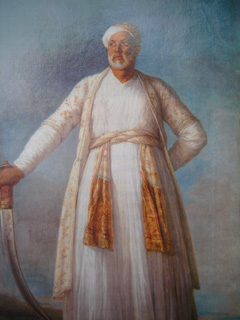To coincide with Ramadan, this week’s choice of picture is Elizabeth Vigee-Lebrun’s portrait of Mohammad Dervish Khan – a startlingly impressive full-length portrait of an ambassador sent to Paris on urgent business by the fiercely independent Islamic ruler Tippu Sultan, last Moghul emperor of Southern India. Painted in 1787, it was publicly exhibited at the Paris Salon of 1789 but subsequently confiscated, along with many other works of art, by the first revolutionary government of France. Vigee-Lebrun, a painter much favoured by Louis XVI and Marie-Antoinette, did not hang around to find out what had become of her picture, escaping from the threat of the guillotine into the safety of exile. She would not return to France for more than a decade. The painting was eventually reclaimed by her husband but then disappeared for more than 200 years. Recently unearthed in a private collection in France, it is currently on display in the V&A’s thoroughly engrossing treasure trove of an exhibition, “Encounters: The Meeting of Asia and Europe 1500-1800”.
Portraits of eighteenth-century Muslims painted from the life are unusual, because of traditional Islamic religious objections to the depiction of human figures in art. Mohammad Dervish Khan was reluctant to sit for his portrait, but diplomatic pressures were brought to bear on him. Given the importance of his mission, the aim of which was to enlist French support in Tippu Sultan’s attempts to expel the British from India, he reluctantly agreed to be painted.
In her memoirs, the persistent and irrepressible Madame Elizabeth Vigee-Lebrun gave a long and entertainingly circumstantial account of how she came to create the painting. She first encountered Mohammed Dervish Khan with his father – theirs was a two-man embassy – at the Opera, where she was struck by their magnificent clothes, “copper complexions” and “splendid features”....


